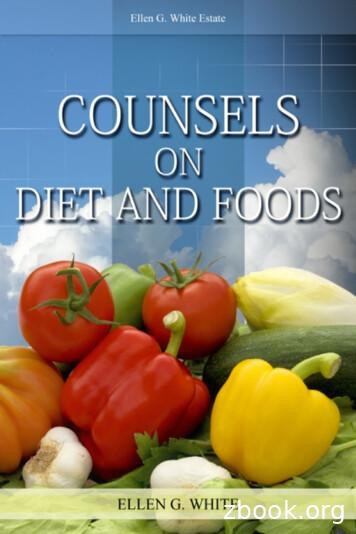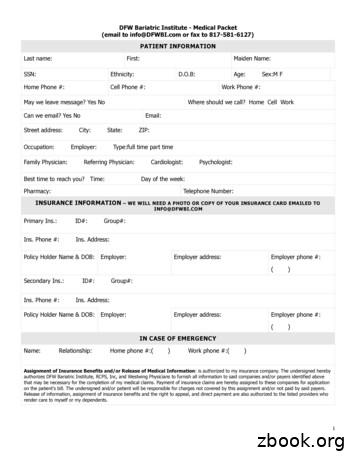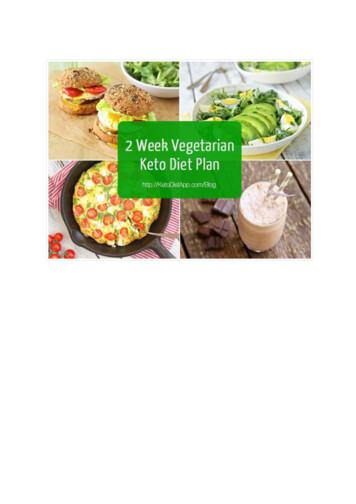Planning A Healthy Diet - Carol Kraft
Chapter 2Planning a Healthy Diet
Objectives: Planning a Healthy Diet After completing Chapter 2, the student will be able to:2.1 Explain how the diet-planning principles can be used to plan ahealthy diet.a.List and apply the six principles of diet-planning.b.Use the USDA Food Patterns to develop a meal plan within aspecified energy allowance.a.Plan a balanced meal using the USDA Food Patterns.b.Identify foods that have a high nutrient density.c.Use the USDA Food Patterns to put a diet plan into actione.Apply the guidelines when shopping for groceries2.3 Compare and contrast the information on food labels to makeselections that meet specific dietary and health goals.a.Identify the information required on the food label.b.Identify the information required on the Nutrition Facts panel c.Recognize reliable health claims on food labels.
Principles and GuidelinesDiet Planning Principles Adequacy Sufficient energyAdequate nutrients for healthy people Balance Enough, but not too much of, different typesof food kCalorie (energy) controlEnergy in energy outHigh nutrient density foods
Estimated Energy Needs forSedentary AdultsEnergy (kcal/day)Women 19-30 years old2000Women 31-50 years old1800Women 51 years old1600Men 19-30 years old2400Men 31-50 years old2200Men 51 years old2000
Principles and Guidelines Nutrientdensity The most nutrients forthe least amount ofkcalories Low-nutrient densityfoods Emptykcalorie foods
Nutrient Density of Two BreakfastOptions Compared
Principles and Guidelines Moderation Food selections – low in fat & added sugars Variety Among and within food groupsBenefits of a varied diet
Principles and Guidelines Dietary Guidelines for Americans Evidence-based advice Attain and maintain a healthy weight Reduce risk of chronic disease Promote overall healthReviewed and revised every five years
Dietary Guidelines for Americans The 2015–2020 Dietary Guidelines-designed to help Americans eat a healthier diet.outlines how people can improve their overall eatingpatterns Followa healthy eating pattern across the lifespan. Focus on variety, nutrient density, and amount. . Limit calories from added sugars and saturated fatsand reduce sodium intake. Shift to healthier food and beverage choices. Support healthy eating patterns for all. www.health.gov/dietaryguidelines
Dietary Guidelines 2015Key Recommendations Consume a healthy eating pattern that accounts for allfoods and beverages within an appropriate calorielevel. A healthy eating pattern includes:[2] A variety of vegetables from all of the subgroups—darkgreen, red and orange, legumes (beans and peas),starchy, and other Fruits, especially whole fruits Grains, at least half of which are whole grains Fat-free or low-fat dairy, including milk, yogurt, cheese,and/or fortified soy beverages A variety of protein foods, including seafood, leanmeats and poultry, eggs, legumes (beans and peas),and nuts, seeds, and soy products Oils
Dietary Guidelines 2015Key Recommendations A healthy eating pattern limits: Saturated fats and trans fats, added sugars, and sodium Added sugars: Consume less than 10 percent ofcalories per day from Saturated fats: Consume less than 10 percent ofcalories per day Sodium: Consume less than 2,300 milligrams (mg) perday of sodium If alcohol is consumed, it should be consumed inmoderation—up to one drink per day for women andup to two drinks per day for men—and only by adults oflegal drinking age.[6]
Diet-Planning Guides USDA FoodPatterns Tool used for diet planning Five major food groups Fruit, Vegetables, Grains, Meats andLegumes, Milk Recommended daily amounts for eachgroup Notable nutrients Serving equivalents Nutrient density
Diet-Planning Guides USDA Food PatternsNotable nutrients Keynutrients of each food group Allows for flexibility in diet plan Greater encouragement of some foodgroups Serving equivalents Fruits,vegetables, milk cups Grains and meats ounces
USDA Food Patterns: Fruitsand VegetablesFruits contribute folate, vitamin A. vitamin C, potassium, and fiber.Consume a variety of fruits, and choose whole or cut-up fruits more often than fruit juice.1 c fruit 1 c fresh, frozen, or cannedfruit½ c dried fruit1 c 100% fruit juiceApples, apricots, avocados, bananas, blueberries, cantaloupe, cherries, grapefruit, grapes,guava, honeydew, kiwi, mango, nectarines, oranges, papaya, peaches, pears, pineapples,plums, raspberries, strawberries, tangerines, watermelon; dried fruit (dates, figs, prunes, raisins);100% fruit juicesLimit these fruits that contain solid fats and/or added sugars:Canned or frozen fruit in syrup; juices, punches, aides, and fruit drinks with added sugars; friedplantainsVegetables contribute folate, vitamin A, vitamin C. vitamin K, vitamin E, magnesium,potassium, and fiber.Consume a variety of vegetables each day, and choose from all five subgroups several times aweek.1 c vegetables 1 c cut-up raw or cookedvegetables1 c cooked legumes1 c vegetable juice2 c raw, leafy greensDark-green vegetables: Broccoli and leafy greens such as arugula, beet greens, bok choy,collard greens, kale, mustard greens, romaine lettuce, spinach, turnip greens, watercressRed and orange vegetables: Carrots, carrot juice, pumpkin, red bell peppers, sweet potatoes,tomatoes, tomato juice, vegetable juice, winter squash (acorn, butternut)Legumes: Black beans, black-eyed peas, garbanzo beans (chickpeas), kidney beans, lentils,navy beans, pinto beans, soybeans and soy products such as tofu, split peas, white beansStarchy vegetables: Cassava, corn, green peas, hominy, lima beans, potatoesOther vegetables: Artichokes, asparagus, bamboo shoots, bean sprouts, beets, brussels sprouts,cabbages, cactus, cauliflower, celery, cucumbers, eggplant, green beans, green bell peppers,iceberg lettuce, mushrooms, okra, onions, seaweed, snow peas, zucchiniLimit these vegetables that contain solid fats and/or added sugars: Baked beans, candied
USDA Food Patterns: Grains and Protein FoodsGrains contribute folate, niacin, riboflavin, thiamin, iron, magnesium, selenium, and fiber.Make most (at least half) of the grain selections whole grains.1 oz grains 1 slice bread½ c cooked rice, pasta, or cereal1 oz dry pasta or rice1 c ready-to-eat cereal3 c popped popcornWhole grains: amaranth, barley, brown rice, buckwheat, bulgur, cornmeal. millet, oats, quinoa.rye. wheat, wild rice and whole-grain products such as breads, cereals, crackers, and pastas;popcornEnriched refined products: bagels, breads, cereals, pastas (couscous, macaroni, spaghetti),pretzels, white rice, rolls, tortillasLimit these grains that contain solid fats and/or added sugars: Biscuits, cakes, cookies,cornbread, crackers, croissants, doughnuts, fried rice, granola, muffins, pastries, pies,presweetened cereals, taco shellsProtein foods contribute protein, essential fatty acids, niacin, thiamin, vitamin B6, vitamin B12,iron, magnesium, potassium, and zinc.Choose a variety of protein foods from the three subgroups, including seafood in place of meator poultry twice a week.1 oz protein foods 1 oz cooked lean meat, poultry, orseafood1 egg¼ c cooked legumes or tofu1 tbs peanut butter½ oz nuts or seedsSeafood: Fish (catfish, cod, flounder, haddock, halibut, herring, mackerel, pollock, salmon,sardines, sea bass, snapper, trout, tuna), shellfish (clams, crab, lobster, mussels, oysters, scallops,shrimp)Meats, poultry, eggs: Lean or low-fat meats (fat-trimmed beet, game, ham, lamb, pork, veal),poultry (no skin), eggsNuts, seeds, soy products: Unsalted nuts (almonds, cashews, filberts, pecans, pistachios, walnuts),seeds (flaxseeds, pumpkin seeds, sesame seeds, sunflower seeds), legumes, soy products(textured vegetable protein, tofu. tempeh), peanut butter, peanutsLimit these protein foods that contain solid fats and/or added sugars: Bacon; baked beans; friedmeat, seafood, poultry, eggs, or tofu; refried beans; ground beef; hot dogs: luncheon meats;marbled steaks; poultry with skin; sausages; spare ribs
USDA Food Patterns: Milk and MilkProducts, and OilsMilk and milk products contribute protein, riboflavin, vitamin B12,calcium, potassium, and, when fortified, vitamin A and vitamin D.Make fat-free or low-fat choices. Choose other calcium-rich foods if youdon't consume milk.Fat-free or 1% low-fat milk and fat-free or 1% low-fat milk products such asbuttermilk, cheeses, cottage cheese, yogurt: fat-free fortified soy milk1 c milk or milk product 1 c milk, yogurt, or fortified soymilk1½ oz natural cheese2 oz processed cheeseLimit these milk products that contain solid fats and/or added sugars:2% reduced-fat milk and whole milk; 2% reduced-fat and whole-milkproducts such as cheeses, cottage cheese, and yogurt; flavored milk withadded sugars such as chocolate milk, custard, frozen yogurt, ice cream,milk shakes, pudding, sherbet; fortified soy milkOils are not a food group, but are featured here because they contributevitamin E and essential fatty acids.Use oils instead of solid fats, when possible.1 tsp oil 1 tsp vegetable oil1 tsp soft margarine1 tbs low-fat mayonnaise2 tbs light salad dressingLiquid vegetable oils such as canola. corn, flaxseed, nut, olive, peanut,safflower, sesame, soybean, sunflower oils; mayonnaise, oil-based saladdressing, soft trans-free margarine; unsaturated oils that occur naturally infoods such as avocados, fatty fish, nuts, olives, seeds (flaxseeds, sesameseeds), shellfishLimit these solid fats:Butter, animal fats, stick margarine, shortening
Serving Size Comparisons 1 cup cooked vegetables a a fist1 medium fruit a baseball¼ cup dried fruit a golf ball3 oz meat a deck of cards2 tbsp peanut butter a marshmallow1 ½ oz cheese 6 stacked dice½ cup ice cream a racquetball4 small cookies 4 poker chips
Serving Sizes http://www.youtube.com/watch?v LBko 3wT44Q
USDA Food Patterns:Recommended Daily Amounts1600 kcal1800 kcal2000 kcal2200 kcal2400 kcal2600 kcal2800 kcal3000 kcal1½ c1½ c2c2c2c2c2½ c2½ c2c2½ c2½ c3c3c3½ c3½ c4cGrains5 oz6oz6oz7oz8oz9oz10 oz10 ozProtein foods5 oz5 oz5½ oz6oz6½ oz6½ oz7oz7oz3c3c3c3c3c3c3c3c5 tsp5 tsp6 tsp6 tsp7 tsp8 tsp8 tsp10 tsp121 kcal161 kcal258 kcal266 kcal330 kcal362 kcal395 kcal459 kcalFruitsVegetablesMilk and milk productsOilsDiscretionary kcalories
Discretionary kcalorie allowance Difference between kcalories supplied and thoseneeded Added sugars and fats
Diet-Planning Guides USDA Food GuideNutrient dense choicesMixtures of foodsVegetarians Can still use USDA Food GuideEthnic food choices
Ethnic Food Choices
Diet-Planning Guides USDAMyPlate –http://www.choosemyplate.gov Educationaltool Combines USDA Food Patternsand Dietary Guidelines Allows for personal planning
Diet-Planning Using the 2000kCalorie USDA Food PatternFood GroupFruitsVegetablesGrainsProtein foodsMilk and milk productsOilsAmounts Breakfast2c½c2½ c6 oz1 oz5½ oz3c1c6 tspLunch1c2oz2 ozSnack½c½ ozDinner1c1½ c2 oz3½ oz1c1½ tspSnack½ oz1c4 tsp
Sample Menu1. Choose thenumber ofservings neededfrom each group.2. Assign foodgroups to dailymeals and snacks.This sample menuprovides about 1850kcalories
Food Group Intake Comparisons
Diet-Planning Guides – GroceryShopping Grains Whole-grain products Fortification &enrichment Vegetables Fresh vs. canned orfrozen Milk and milk products Lowfat or skim Fruits Colors Fruit juices Protein foods Lean cuts Soy products Portion sizes Cooking techniques
From Guidelines to Groceries Grains Refinedfoods lose nutrients during processing. Enriched foods have nutrients added back thatwere lost during processing, including iron,thiamin, riboflavin, niacin, and folate. Whole-grain products are not refined. Examplesinclude brown rice and oatmeal. Fortified foods have nutrients added that werenot part of the original food. Processedfoods-have been treated to change their properties may have lost nutrients and gained sugar, fat andsalt
A Wheat Plant
Guidelines to Groceries Examples of whole grains include:Barley, buckwheat, bulgur, corn, popcorn,couscous, oats and oatmeal, brown rice,whole wheat, whole rye Readyto eat breakfast cereals are themost highly fortified foods on the market Grains are enriched with: Iron, Thiamin, Riboflavin, Niacin, Folate
From Guidelines to Groceries Vegetables Choose fresh vegetables often.Dark green leafy and yellow-orange vegetables are important.Good sources of vitamins, minerals, and fiberBe careful to control added fat and salt.Legumes Variety is importantEconomicalLow-fat, nutrient-rich and fiber-rich
From Guidelines to Groceries Fruit Choosecitrus and yellow-orange fruits. Processed fruits are acceptable alternatives tofresh. Provides vitamins, minerals, fibers andphytochemicals Fruit juices lack fiber but are healthy beverages. Watch energy intakes and fruit “drinks.”
From Guidelines to Groceries Meat, fish and poultryProvides minerals, protein and B vitaminsChoose lean cuts.Textured vegetable protein is a processedsoybean protein and can be used inrecipes.Weighing can be used to determine portionsizes.Use low-fat cooking methods, and trim anddrain fat to reduce fat intake.
From Guidelines to Groceries Milk Dairy foods are often fortified with vitaminsA and D.Imitation foods that resemble other foodsare nutritionally inferior.Food substitutes are designed to replaceother foods.Many lower fat dairy products are availableincluding fat-free, non-fat, skim, zero-fat,no-fat, low-fat, reduced-fat, and less-fatmilk.
New Food Labels trition/217068 w400573 feb272014 v01 nutrition labels.mp4
Understanding Food Labels
Food Labels Ingredient list Listing of all ingredientsDescending order of predominance by weightServing sizes Standards are established by Food and DrugAdministration (FDA)Adjust calculations according to amountconsumedSizes listed vs. USDA Food Pattern sizes
Food Labels Nutrition FactsServing sizes and Daily ValuesRequired information Totalfood energy (kcalories) Kcalories from fat Total fat; saturated fat; trans fat; cholesterol Sodium Total carbohydrate; dietary fiber; sugars Protein Vitamins A & C; iron; calcium
Food Labels Nutrition FactsListed by quantity andpercentage standards perserving, called Daily ValueskCalories listed as total kcaloriesand kcalories from fatFat listed by total fat, saturatedfat, and trans fatCholesterolSodiumCarbohydrate listed by totalcarbohydrate, starch, sugars,and fiberProteinVitamin A, vitamin C, iron, andcalcium are listed in % DV only.
Daily Values for Food Labels Basedon a 2000kcalorie diet Ballpark estimate ofhow a foodcontributes to thetotal diet
Nutrient and Health ClaimsLow calorieLow fatOatmeal helps reduce cholesterolRich in calciumGood source of fiberHelps promote a healthy heart
Label Claims
Food Label Terms Fat/SodiumFat Free Less than 0.5 gm of fat per servingLow Fat 3 gm or less fat/servingLess Fat 25% or less fat than the comparisonfoodLow Cholesterol 20 mg or less Cholesterol Low Sodium 140 mg or less per servingVery Low Sodium 35 mg or less per serving Lite or Light- 50% or less of the fat or sodiumthan the comparison food
Food Label Terms Kcalories Kcal Free Light OneLess than 5 kcal/Servingthird fewer Kcal than thecomparison food Low Calorie 40 Kcal or less perserving Reduced Calorie At least 25% fewerKcal per serving than the comparisonfood Fiber High Fiber 5 grams or more of fiberper serving
Example Test QuestionsWhich food group is typically consumed in amounts greater than recommended by the USDA? a.b.c.d.e. dairy fruits vegetables protein foods whole grains. Refined grain products contain only the . a.b.c.d.e. bran husk germ endosperm chaffANSWER:. What is a feature of the Daily Values found on food labels? a.b.c.d.e. They are updated every two years asmandated by the USDA. They are expressed on a "per 1000-kcalorieintake" basis. They assist people in determining whether afood contains a little or a lot of a nutrient. They define a food as an excellent source ofa nutrient if it contributes at least 50% of thedietary recommended intake. They assign grades of A, B, C, D, or F to foods.c
Vegetarian DietsHighlight 2
Vegetarian Diets HealthBenefits of Vegetarian Diets Lifestyle practices are often different fromomnivores Healthy body weights are common due to high intakes offiber and low intakes of fat.Blood pressure is often lower due to lower body weights,low-fat and high-fiber diets, and plenty of fruits andvegetables.Lower incidence of heart disease due to high-fiber diets,eating monounsaturated and polyunsaturated fats, andlow intakes of dietary cholesterol Inclusion of soy products like tofu and tempehLower incidence of cancer due to high intakes of fruitsand vegetablesOther diseases
Vegetarian Diet Planning Specificinformation for planning avegetarian diet can be found atmyplate.gov Protein Lacto-ovo-vegetarians consume animal-derivedproducts and thus high-quality protein. Meat replacements and textured vegetableprotein can be used.Iron - Iron-rich vegetables and fortified grain productsconsumed with foods that are high in vitamin C canhelp vegetarians meet iron needs.Zinc - Consuming legumes, whole grains, and nutscan provide zinc to those who do not consumemeat.
Vegetarian Diet Planning Calcium Calcium is not an issue for thelactovegetarian.Calcium-rich foods should be consumed. Vitamin B12Vegans may not receive enough B12 fromthe diet.Consumption of fortified products orsupplementation may be necessary. VitaminD can come from sunlightexposure or fortified foods. Omega-3 Fatty Acids - Food sourcesinclude flaxseed, walnuts, soybeans, andtheir oils.
Good Vegetarian Sources of KeyNutrients
Healthy Food Choices Avariety of food is the key to adequacy.Be careful of macrobiotic diets. Meal patterns are changed. Diet and other lifestyle habits need to behealthy.
Objectives: Planning a Healthy Diet After completing Chapter 2, the student will be able to: 2.1 Explain how the diet-planning principles can be used to plan a healthy diet. a.List and apply the six principles of diet-planning. b.U
Sep 02, 2002 · Ocs Diet Smoking Diet Diet Diet Diet Diet Blood Diet Diet Diet Diet Toenails Toenails Nurses’ Health Study (n 121,700) Weight/Ht Med. Hist. (n 33,000) Health Professionals Follow-up Study (n 51,529) Blood Check Cells (n 68,000) Blood Check cell n 30,000 1976 19
AQA GCSE Biology – Unit 1 summary notes Page 2 B1.1 Keeping Healthy B1.1.1 Diet and Exercise Summary A combination of a balanced diet and regular exercise is needed to help keep the body healthy. Healthy Diet x A healthy diet contains the right balance of the
Testimony Studies on Diet and Foods, was soon exhausted. A new and enlarged volume, titled Counsels on Diet and Foods, Appeared in 1938. It was referred to as a “second edition,” and was prepared under the direction of the Board of Trustees of the Ellen G. White Estate. A third edition, printed in a smaller pageFile Size: 1MBPage Count: 408Explore furtherCounsels on Diet and Foods — Ellen G. White Writingsm.egwwritings.orgCounsels on Diet and Foods — Ellen G. White Writingsm.egwwritings.orgEllen G. White Estate: A STUDY GUIDE - Counsels on Diet .whiteestate.orgCounsels on Diet and Foods (1938) Version 105www.centrowhite.org.brRecommended to you b
(not hungry at all) 0---1---2---3---4---5---6---7---8---9---10 (so hungry you get cramps) 8 Dieting History . Atkins Mayo Clinic diet Subway diet HCG Diet Pritkin diet Fasting The Zone Raw diet Caveman diet South Beach Blood Test diet Low Ca
Zone Diet Typical U.S. Diet Rice Diet) Duke MCD 20 0 50 100 200 300 Calories/day 1000 (Ketonuria) Low Glycemic Index Diet Mediterranean Diet Protein Power, Paleo, So. Beach Phase 1, Duke LCD Atkins Induction, Keto So. Beach Phase 2 Atkins Maintenance DASH Diet VLCD Low Carbohydrate Ketogenic Diet
Low Carb Low Fat Hypnosis Atkins Diet Mayo Clinic Diet Richard Simons Scarsdale Diet Sugar Busters Slim Fast South Beach Diet Acupuncture Diet Pills from MD Diet Shots from MD Diet Center Jenny Craig Overeaters Anonymous Optifast / Medifast LA Weight Loss Nutri System Psychological Counse
And here is a quick overview of this diet plan in PDF. Although it's just a quick preview of the diet plan, we've been working on a complete ebook including recipes so stay tuned! :-) Also see more diet plans here ("regular" ketogenic diet plan, keto & paleo diet plan and diet plan for the fat fast.)
BAB 6 LEMBAGA JASA KEUANGAN DALAM PEREKONOMIAN INDONESIA KOMPETENSI INTI 3. Memahami, menerapkan, menganalisis pengetahuan faktual, konseptual, prosedural berdasarkan rasa ingin tahunya tentang ilmu pengetahuan, teknologi, seni, budaya, dan humaniora dengan wawasan kemanusiaan, kebangsaan, bakat dan minatnya untuk memecahkan masalah kenegaraan, dan peradaban terkait penyebab fenomena dan .























